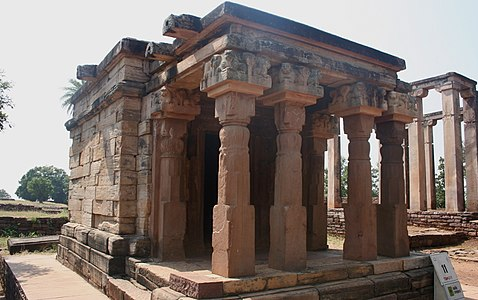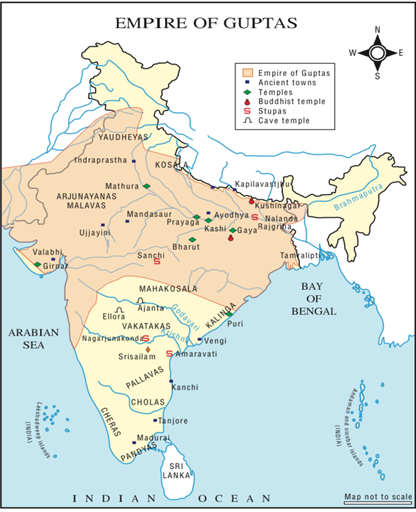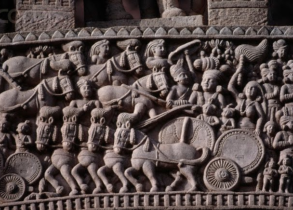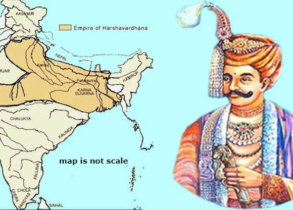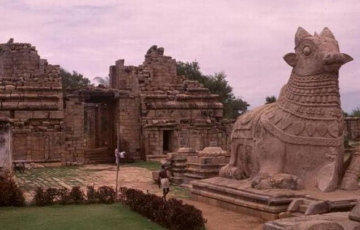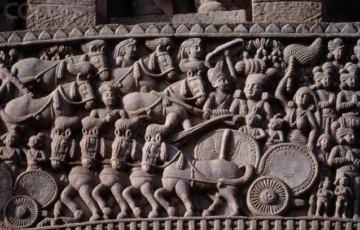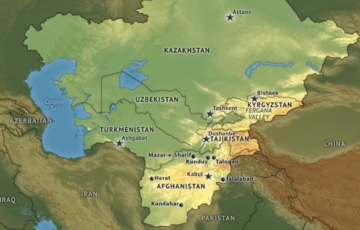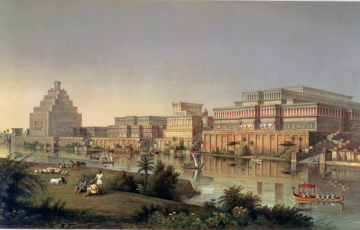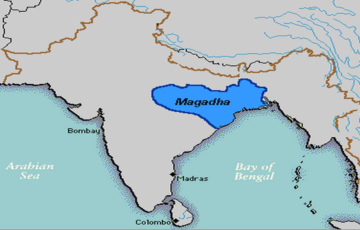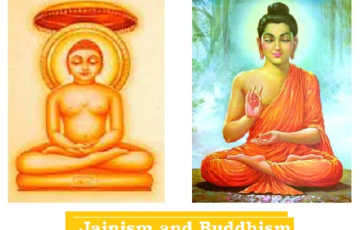THE GUPTA EMPIRE
Introduction
The Gupta Empire emerged in the mid-3rd century AD following the decline of the Satavahanas, Kushans, and Murundas.
- Initially, the Guptas may have been vassals of the Kushans in Uttar Pradesh, with their power center in Prayaga.
- The Murundas, related to the Kushans, ruled central India from 230 AD to 250 AD after the Kushans’ decline in North India.
- It is widely believed that the Guptas were of Vaisya origin.
- Although not as expansive as the Mauryan Empire, the Gupta Empire effectively unified North India for over a century under a strong central government, subjugating numerous kingdoms.
- The Gupta rule encompassed territories such as Anuganga (the middle Gangetic Basin), Prayag, Saketa (modern Ayodha), and Magadh.
- Their dominion extended to significant portions of the West and Northwest, and they reached the East coast of the Deccan, extending as far as the Pallava Kingdom.
Factors contributing to the ascent of the Gupta Empire
- Abundance of fertile land in the Madhyadesha region, spanning Bihar and Uttar Pradesh, provided a strong agricultural base for the Guptas.
- Access to iron ores from regions in South Bihar and Central India facilitated the development of metallurgy and military strength.
- Proximity to North Indian areas engaged in silk trade with the Byzantine Empire allowed the Guptas to capitalize on lucrative commercial opportunities.
Important Rulers
The Gupta dynasty was established by Sri Gupta (240–280 AD), followed by Ghatotkacha (280–319 AD), both of whom assumed the title of ‘Maharajas’.
Chandragupta I (319-335 AD)
- He initiated the Gupta era in 319-20 AD and was the first ruler to be titled Maharajadhiraja, signifying his significant conquests.
- As a Vaishya, he strategically married Princess Kumaradevi of the Kshatriya lineage of Licchavi from Nepal, aiming to enhance the prestige and extend the political influence of the dynasty.
- The Licchavis were a prominent Gana-sangha situated between the Ganges and the Nepal Terai.
- Unfortunately, no inscriptions or coins from Chandragupta I’s reign have survived.
Samudragupta (335-375 AD)
- He is the son and successor of Chandragupta I, pursued a policy of conquest, in contrast to Ashoka’s policy of peace.
- The Allahabad pillar inscription, composed in Sanskrit by Harisena, mentions his military campaigns.
- His conquests can be categorized into five groups:
- Conquest of the Ganga-Yamuna doab.
- Subjugation of Himalayan and frontier states such as Assam, Nepal, Bengal, and Punjab.
- Expansion into the forest kingdom of the Vindhyan region, known as Atavika Rajya.
- Expedition into Dakshinapatha against 12 rulers of the eastern Deccan and South India, reaching up to Kanchi (Tamil Nadu), where the Pallavas acknowledged his suzerainty.
- Campaign against the Sakas and Kushans, some of whom ruled in Afghanistan.
- Under his reign, nine Republics in Rajasthan, including the Malavas and Yaudheyas, were compelled to accept Gupta suzerainty.
- Meghavarman, the ruler of Sri Lanka, sought permission from him to build a Buddhist temple at Gaya.
- He earned the epithet “Napoleon of India” from A. Smith due to his record of never facing defeat.
- He conducted the Asvamedha sacrifice and issued gold and silver coins bearing the legend “restorer of the Asvamedha”.
- Despite being a devoted follower of Vaishnavism, he displayed tolerance towards other sects and patronized the great Buddhist scholar Vasubandhu.
- Known for his love of poetry and music, he was bestowed with the title “Kaviraja”.
Chandragupta II (375 – 415 AD)
- He is the son of Samudragupta, ascended to power after a succession struggle with his brother Ramagupta.
- His reign marked the pinnacle of the Gupta Empire’s power and represented the zenith of territorial expansion.
Alliance and Conquest:
- He expanded his empire through a combination of marriage alliances and military conquests.
- He married Kuberanaga, a Naga princess from Central India.
- His daughter, Prabhavati, was wedded to Rudrasena II, a Vakataka prince of the Deccan, strategically strengthening ties in the region.
- By defeating and killing the last Saka satrap ruler, he earned the title “Sakari” (destroyer of Sakas), annexing territories in western Malwa and the Kathiawar peninsula into the Gupta Empire.
- This conquest of Western India facilitated Gupta control over key seaports such as Broach, Sopara, and Cambay, enhancing trade relations with Western countries.
- He expanded his dominion by defeating northern adversaries like the Huns, Kambojas, and Kiratas.
- The Mehrauli Iron Pillar inscription attests to his extensive conquests.
- He adopted the title Vikramaditya, previously used by a Ujjain ruler in 58 BC, along with other names such as Vikrama, Devagupta, Devaraja, and
- Ujjain was possibly designated as his secondary capital.
- He was the first Gupta ruler to issue silver coins.
- Fa Hein, the Chinese traveler, visited the Gupta Empire during his reign.
- He was renowned for maintaining nine luminaries or great scholars at his court.
| The Nine Luminaries or ‘Navaratnas’
1. Dhanvantari – Known for his expertise in medicine. 2. Kalidasa – Renowned playwright and poet, famous for works like “Abhijnana Shakuntalam” and “Vikramorvashiyam”. 3. Vararuchi – Noted for his contributions to Vyakarana (grammar). 4. Sanku – Expert in Silpasastra (architecture). 5. Vittal Bhat – Known for his proficiency in Mantra Shastra (music). 6. Varahamihira – Author of “Panchasiddhantika”, a significant astronomical work. 7. Amarasimha – Notable for composing the “Amarakosha”, a Sanskrit lexicon. 8. Kshapanaka – Expert in Jyotishya sastra (astrology). 9. Harisena – Noted for his composition of the Allahabad pillar inscription. |
Fa Hein’s Visit (399-414 AD)
- Fa Hein, a Chinese pilgrim, journeyed to India during the reign of Chandragupta II.
- He traveled to India via the land route through Khotan, Kashgar, Gandhara, and Punjab, and returned via the sea route, visiting Ceylon and Java.
- Fa Hein explored several significant sites during his travels, including Peshawar, Mathura, Kanauj, Sravasti, Kapilavastu, Kusinagara, Pataliputra, Kasi, and Bodh Gaya.
- He depicted the people of Mathura as numerous and content, and those of Pataliputra as affluent and prosperous.
- The primary objective of his journey was to visit the land associated with Buddha and to procure Buddhist manuscripts from India.
- His accounts offered valuable insights into the religious, social, and economic conditions prevalent during the Gupta Empire.
- Fa Hein’s focus remained primarily on religion, showing little interest in political matters.
Kumaragupta I (415-455 AD)
- Also known as Sakraditya, Kumaragupta I was the son of Chandragupta II.
- His reign was characterized by a period of general peace and prosperity.
- He issued a considerable number of coins and conducted the Asvamedha sacrifice.
- He laid the groundwork for the establishment of Nalanda University.
- Despite the relative peace, his reign faced challenges, notably incursions by a branch of Huns from Central Asia attempting to invade India.
Skandagupta (455-467 AD)
- He is the son of Kumaragupta, marked the final great ruler of the Gupta dynasty.
- He successfully repelled an attack by the Huns, but subsequent invasions strained the empire’s resources.
- The Bhitari monolithic pillar inscription provides significant insights into Skandagupta’s reign, documenting his accomplishments and challenges.
Administration during the Gupta Age
- Political hierarchies were delineated by the titles adopted by rulers.
- Gupta kings assumed titles such as Paramabhattaraka, Maharajadhiraja, Parameswara, Samrat, and Chakravartin.
- Some historians suggest that Gupta Kings asserted divine status; for instance, Samudragupta was likened to Purusha (the Supreme Being) in the Allahabad inscription.
- The Gupta Empire boasted a robust central government, effectively subjugating numerous kingdoms and bringing them under its hegemony.
- Feudalism began to emerge as an institution during this period, indicating a decentralized system of governance with local lords or feudal lords exerting authority over specific territories.
King:
- The king was revered as an embodiment of God Vishnu, the protector and preserver.
- Kings were often associated with gods through epithets like Parama-Daivata (foremost worshipper of the gods), Parama-Bhagavata (foremost worshipper of Vasudeva Krishna), and
- Kingship was typically hereditary, but there was no strict practice of primogeniture.
Ministers and Officials:
- The king’s administration was supported by a council comprising a chief minister, a Senapati (commander-in-chief of the army), and other key officials.
- The king maintained close ties with provincial administration through officials known as Kumaramatyas and Ayuktas.
- Compared to the Mauryas, the Gupta rulers required fewer officials due to the lesser involvement of the state in economic activities and the presence of guilds to manage affairs.
- Recruitment to various positions was not restricted solely to the upper varnas.
- Over time, many positions became hereditary, leading to a weakening of royal control.
- Among the most significant officers were Kumaramatyas, who possibly received monetary compensation for their services.
- Kumaramatyas:
- The term “Kumaramatya” is found on six Vaishali seals, indicating an office (Adikarana) of significance.
- They held a prominent position among Amatyas (ministers) and were regarded as equivalent in status to princes of royal lineage.
- They served in various capacities, including being attached to the king, crown prince, revenue department, or a specific province.
- Individuals holding the rank of Kumaramatya often carried additional designations.
- For instance, Harisena, the son of Dhruvabhuti and a mahadandanayaka (high-ranking military officer), held the titles of Kumaramatya, Sandhivigrahaka, and Mahadandanayaka.
| Officers in the Gupta Empire
● Mantriparishad: Council of ministers ● Amatyas or Sachivas: Executive officers in charge of various departments ● Sandhivigrahaka: Minister for foreign affairs, war, and peace ● Mahabaladhikrita and Mahadandanayaka: Superior posts in the army ● Mahapratiara: Chief of the palace guards ● Mahashvapati: Commander of Cavalry ● Dandapashika: Chief officer of the police department ● Dutakas: Spies ● Pilupati: Head of the elephants department ● Asvapati: Head of the horse department ● Narapati: Head of foot soldiers ● Akshapataladhikrita: Keeper of royal records ● Saulkika: Collector of customs and tolls ● Uparikas: Provincial Governors ● Khadyatapakita: Superintendent of the Royal kitchen ● Lokpala: Possibly referred to as a provincial governor |
Army in the Gupta Empire
- The king maintained a standing army, occasionally supplemented by forces from feudatories.
- Borrowing from the Kushans, the Guptas adopted innovations such as saddles, reins, buttoned coats, trousers, and boots, enhancing mobility and horsemanship.
- Chariots and elephants were less prominent in the Gupta Army, with the focus shifting to cavalry and horse archery.
- Military designations like Baladhikrita and Mahabaladhikrita (commanders of infantry and cavalry) are mentioned in seals and inscriptions.
- While the term “Senapati” (commander-in-chief) is not prevalent in Gupta inscriptions, it is found in Vakataka epigraphs.
- A Vaishali seal references the Ranabhandagar-Adhikarana, the office of the military storehouse, indicating the importance of logistics in Gupta military operations.
Division of the Gupta Empire
Bhuktis →Vishyas→Vithi→Villages
Provinces / Bhuktis
- The Gupta Empire was organized into provinces known as Deshas or Bhuktis, which were overseen by Uparikas (governors).
- Uparikas were appointed directly by the king and held authority over both civil administration and military affairs.
- Within each province, the Uparika appointed officials to manage district administration and district boards.
- The Damodarpur plates refer to Uparikas with the title of maharaja, denoting their elevated status and rank within the administrative hierarchy.
- The Eran pillar inscription of Budhagupta, dated Gupta year 165 AD, mentions Maharaja Surashmichandra as a Lokpal, responsible for governance over the territory situated between the Kalinndi and Narmada rivers.
Districts / Vishayas
- Within the bhuktis or provinces, districts known as Vishayas were established, each governed by officers referred to as Vishyapatis.
- Vishyapatis were typically appointed by provincial governors, although in some cases, kings directly appointed them.
- Administrative duties in Vishayas were often assisted by prominent members of the towns.
- In urban administration, Guilds, also known as Shrenis, played a significant role in organizing professional bodies and managing their own affairs. They also enforced guild laws and administered punishments for violations.
Vithis and Villages
- Below the district level, smaller administrative units existed, known by various names such as vithi, bhumi, pathaka, and peta.
- Officials such as Ayuktakas and Vithi-Mahattaras oversaw these areas.
- At the village level, functionaries like Gramika and Gramadhyaksha were chosen by the villagers to manage local affairs.
- The Damodarpur copper plate from the reign of Budhagupta mentions an Ashtabula-Adhikarana (board of eight members) led by the Mahattara or village headman.
- The Sanchi inscription during the time of Chandragupta II mentions the Panchmandali, which likely refers to a corporate body operating at the village level.
Feudatory System of the Gupta Empire
- A significant portion of the Gupta Empire was controlled by feudatory chiefs or vassals, also referred to as Samantas.
- Charters issued to vassals residing on the periphery of the empire often bore the Royal ‘Garuda’ seal, signifying their status and relationship with the central authority.
- Feudatory chiefs had certain obligations, including:
- Personal attendance to the king when required.
- Payment of tribute to the king as a form of acknowledgment of their vassalage.
- Presentation of daughters for marriage to the king or members of the royal family, strengthening political alliances through matrimonial ties.
Economy during the Gupta Era
The “Nitisara,” authored by Kamandaka, serves as a significant text akin to the Arthashastra, focusing on the importance of the royal treasury and outlining various sources of revenue for the administration.
Agriculture during the Gupta Era
- Agriculture experienced significant growth due to the expansion of irrigation systems. Fields and crops were protected with fences, and those found damaging crops faced punishment.
- Crops cultivated during this period included rice, wheat, barley, peas, lentils, various pulses, sugarcane, and oilseeds.
- According to Kalidasa, southern India was renowned for its production of pepper and cardamom.
- Varahamihira provided detailed instructions on the cultivation of fruit trees, indicating a focus on horticulture.
- The Paharpur Copper Plate Inscription
- The king held exclusive ownership of the land.
- An officer named Ustapala was tasked with overseeing and documenting all land transactions within the district.
- Village accountants were responsible for maintaining land records at the village level.
Irrigation Techniques
- The Narada Smriti mentions two types of dykes:
- Bardhya: These dykes were designed to shield fields from floods.
- Khara: Serving as irrigation channels, Khara dykes facilitated controlled water flow for agricultural purposes.
- Jalanirgamah: Drains were constructed to prevent field inundation, effectively managing water levels.
- Canals were constructed using water sources from rivers, tanks, and lakes, not solely relying on river water for irrigation.
- One notable example is the Sudarshana Lake located at the base of the Girnar Hills in Gujarat, renowned for its significance in irrigation and agriculture during the Gupta period.
Land Classification during the Gupta Period
- Kshetra: Refers to cultivable land suitable for agriculture.
- Khila: Designates waste or uncultivated land.
- Aprahata: Denotes jungle or wasteland, typically unsuitable for cultivation.
- Vasti: Indicates habitable land suitable for settlement or living.
- Gapata Saraha: Represents pastoral land used for grazing purposes.
Land Grant System
- The practice of granting fiscal and administrative concessions, which began with the Satavahanas, became a regular practice during the Gupta era.
- A significant development during this period was the rise of priestly landlords at the expense of local peasants.
- Religious functionaries received land grants exempt from taxes indefinitely, allowing them to collect taxes from the peasants, thereby expanding cultivation.
- This system often subjected local peasants and tribals to forced labor and reduced them to serfdom, reinforcing caste-based hierarchies.
- Priests granted land were empowered to administer justice and punish criminals within their granted lands.
- Various types of land grants existed:
- Agrahara grants: Granted to Brahmins, these were perpetual, hereditary, and tax-free.
- Devagraha grants: Land grants given to Brahmins, along with gifts to merchants for temple repair and worship.
- Secular grants: Grants made to feudatories of the Guptas for their services.
Different Land Tenure Systems
- Nivi dharma: Land endowed under a form of trusteeship, prevalent in North and Central India and Bengal.
- Nivi dharma aksayana: A form of perpetual endowment where the recipient could utilize the income derived from the land.
- Aprada dharma: Recipients could enjoy the income from the land but were prohibited from gifting it to others. They also lacked administrative rights over the land.
- Bhumichchi-dranyaya: Right of ownership acquired by individuals who cultivated barren land for the first time. Such land was exempt from rent liabilities.
- Kulyavapa and Dronavapa were distinct measurements of land during the Gupta period.
Taxation
- Land taxes, commonly known as Baga or Bhoga, saw an increase, while taxes on trade and commerce decreased.
- Land taxes were typically a percentage of the produce, varying from 1/4th to 1/6th of the total yield.
- In central and western India, villagers were subjected to forced labor known as ‘Vishti,‘ considered a form of tax paid by the people.
- Gupta inscriptions mention the term Iranyavesti in connection with forced labor.
- Inscriptions related to Vishti were predominantly found in the Madhya Pradesh and Kathiawar regions.
| Different Kinds of Taxes
● Bhaga: King’s customary share of the produce, typically one-sixth, paid by cultivators. ● Bhoga: Periodic supply of fruits, firewood, flowers, etc., provided by the village to the king. ● Kara: Periodic tax levied on villagers, separate from the annual land tax. ● Bali: Initially a voluntary offering to the king but later became compulsory and oppressive. ● Udianga: A tax for either maintaining police stations or as a water tax, considered an additional levy. ● Uparikara: Another form of additional tax. ● Hiranya: Tax payable on gold coins, possibly also the king’s share of certain crops paid in kind. ● Vata-Bhuta: Various cesses for maintaining rites for the winds (Vata) and spirits (Bhuta). ● Halivakara: Plough tax paid by cultivators who owned ploughs. ● Sulka: Royal share of merchandise brought into a town or harbor by merchants, akin to customs and tolls. ● Klipta and Upaklipta: Taxes related to the sale and purchase of lands. |
Trade during the Gupta Period
Both internal and external trade thrived during the Gupta era, facilitated by roadways and river routes. Roads were secure for travelers, minimizing the risk of theft.
- The Narada and Brihaspati Smritis detail the organization and functions of guilds, which wielded significant economic and political influence.
- Two distinct types of traders existed:
- Sresti, settled traders, and
- Sarthavaha, caravan traders who transported goods to various locations.
- Usury, the lending of money at excessively high interest rates, was practiced during this period.
- According to Fa Hien, Tamralipti in Bengal served as a vital port engaged in trade with China, Sri Lanka, Java, and Sumatra.
- He also highlighted the dangers of the sea route between India and China.
- Other important ports within the Gupta Empire included Kalyan (Calliena) and Chaul in Maharashtra, Broach and Cambay in Gujarat, Kadura and Ghantasala in Andhra.
- The Malabar coast hosted bustling markets in Male, Mangarouth (Mangalore), Salopatana, Nalopatana, and Pandopatana.
Export and Import Items
- Exported goods included cotton textiles from Bengal, indigo from Bihar, silk from Banaras, Himalayan scents, sandalwood and spices from the south, pearls, precious stones, coconuts, and ivory.
- Imported items comprised gold, silver, tin, lead, silk, and horses.
- Western traders exchanged Roman gold for Indian products.
- The trade of silk with the Eastern Roman Empire declined around 550 AD as the Romans began cultivating silk themselves, learning the art from the Chinese.
Mining and Metallurgy
- Extensive mining of iron ore from Bihar and copper from Rajasthan occurred during this era due to rich deposits.
- Notable figures like Amarasimha, Varahamihira, and Kalidasa frequently referenced the presence of mines.
- Besides iron, various metals were utilized, including gold, copper, tin, lead, brass, bronze, bell-metal, mica, manganese, antimony, red chalk (Sanssilajata), and red arsenic.
- The Mehrauli iron pillar, attributed to King Chandragupta II and located within the Qutb Minar complex in Delhi, was crafted in the 4th century AD.
- Remarkably, it has remained free of rust, highlighting the exceptional craftsmanship of the Gupta era.
Coinage
- The Guptas primarily issued a significant quantity of gold coins, with comparatively fewer silver and copper
- Subsequent to the Gupta era, there was a decline in the circulation of gold coins.
- Most Gupta coins feature legends and symbols, offering insights into the titles and religious sacrifices performed by Gupta monarchs.
- Goddess Lakshmi, depicted as the wife of Vishnu, often appears on the reverse side of the coins.
- Gupta coins closely resemble Greek and Kushan coins in design, execution, and artistic composition.
- The earliest Gupta coins, featuring the images of Kumaradevi and Chandragupta I, are notable.
- Samudragupta’s coins, for instance, encompass eight types of gold coins, with some portraying him playing the lute (veena).
- Chandragupta II and his successors issued coins in gold, silver, and copper.
- From the middle of the fifth century onwards, Gupta kings attempted to sustain their gold currency by reducing the gold content, albeit unsuccessfully.
Society
- Brahmana supremacy persisted, leading to the accumulation of wealth by Brahmanas through numerous land grants.
- The caste system became rigid, with the proliferation of numerous sub-castes due to the assimilation of foreigners into Hindu society and the absorption of many tribes into Brahmanical society.
- For instance, the Huns came to be recognized as one of the clans of Rajputs.
- Sudras, who previously served as servants, slaves, and agricultural laborers, transitioned to becoming agriculturists. The distinction between Vaishyas and Sudras blurred over time.
- Untouchability began to emerge, with chandalas increasing in number and being segregated from mainstream society.
- The position of women deteriorated significantly:
- They were prohibited from studying religious texts like Puranas.
- Practices like Swayamvara (self-choice of a husband) were abandoned, and early marriage for girls was advocated by Manusmriti.
- The practice of Sati gained social acceptance during this period, with the Eran inscription of Bhanugupta providing the earliest evidence.
- Property rights for women were generally denied, although the inscription of Prabhavati Devi indicates that she owned land in her name.
- The custom of women changing their gotra upon marriage emerged after the 5th century AD.
Religion
- Brahmanism gained prominence, with the worship of Shiva and Vishnu coming to the forefront. Images of Vishnu, Shiva, and other deities began to appear.
- Many Gupta kings were Vaishnavaites, and religious literature like the Puranas emerged during this era. Vishnu became associated with devotion and the preservation of the varna system.
- Works such as the ‘Vishnupurana’ and ‘Vishnusmriti’ were composed in honor of Vishnu.
- The Bhagavad Gita, emphasizing devotion to Lord Krishna and the performance of duties according to varna, appeared in the 4th century AD.
- The Gangetic Valley was referred to as the “island of Brahmanism” by Fa Hein.
- Idol worship became prevalent, and agricultural festivals took on religious significance, becoming a source of income for priests.
- While Buddhism thrived in northwestern India, it declined in the Gangetic Valley, losing royal patronage.
- Jainism flourished in western and southern India, with the compilation of the Jain canon of Svetambaras occurring during the Gupta era.
- Gupta kings pursued a policy of tolerance, with no evidence of persecution against followers of Buddhism and Jainism.
Judicial System
- The judicial system was significantly more developed compared to earlier times, with a clear distinction between civil and criminal law.
- Criminal offenses such as theft and adultery were covered under criminal law, while property disputes fell under civil law.
- Detailed laws were established regarding inheritance.
- Various courts, including Karana, Adhikarana, and Aharmasana, were established to handle different types of cases.
- The king served as the upholder of the law and presided over cases, often assisted by Brahmana priests.
- Guilds of artisans, merchants, and other groups had their own sets of laws governing their activities.
- Laws were influenced by varna distinctions, with culprits from higher varnas often receiving lighter punishments.
- Punishments were not excessively severe, with fines being a common form of punishment.
Art and Architecture
- The Gupta period is often hailed as the Golden Age of ancient India, especially in terms of arts and cultural advancements.
- Art during this period was predominantly influenced by religion, with a focus on religious themes and Non-religious art forms were rare.
- Buddhist Art:
- Sculptures included a bronze image of Buddha in Sultanganj near Bhagalpur, along with images of Buddha from Mathura and Sarnath.
- Paintings at Ajanta Caves are renowned for their lifelike portrayal and vibrant colors, depicting various events from the life of Buddha.
- Similar paintings are found at the Bagh caves in Dhar, Madhya Pradesh, and at Sigiriya in Sri Lanka, which were highly influenced by the Ajanta style.
- Stupas: They were prominent architectural features during the Gupta period, found in locations such as Samat (Uttar Pradesh), Ratnagiri (Orissa), and Mirpur Khas (Sind).
Temple Architecture
- Both Nagara and Dravidian styles of temple architecture evolved during the Gupta period, although much of the architectural heritage from this time has been lost due to foreign invasions like those of the Huns.
- Unlike earlier periods, there was no significant influence of the Gandhara style in temple architecture during the Gupta era.
- Temples predominantly housed images of Hindu gods such as Vishnu, Shiva, and others.
- The primary deity was typically depicted in a large central shrine, surrounded by smaller images of subordinate gods.
- Few brick temples from this era have survived, notable examples being the temples of Bhitargaon in Kanpur, Bhaitari in Ghazipur, Nachnakutara in Panna, and Deogarh in Jhansi.
- The sculptures found in temples, such as those at Garhwas near Allahabad, are significant specimens of Gupta art.
- The earliest known brick structure of Nalanda University, founded by Kumargupta, a prominent center of learning, also dates back to the Gupta period.
| Nalanda University
● It stood as a renowned Mahavihara and Buddhist monastery. ● Recognized as a UNESCO World Heritage site, Nalanda served as a prestigious center of learning from the 5th to the 12th century AD. ● Under Gupta patronage in the 5th and 6th centuries, and later under Harsha of Kannauj, Nalanda flourished as a hub of education. ● At its zenith, Nalanda attracted scholars and students from regions as far-reaching as Tibet, China, Korea, and Central Asia. ● Archaeological evidence suggests connections with the Shailendra dynasty of Indonesia, with one of its kings contributing to the monastery’s construction. ● Despite its illustrious history, Nalanda met a tragic fate when it was ransacked and devastated by the forces of the Mamluk dynasty of the Delhi Sultanate, led by Bakhtiyar Khalji, in 1200 AD. |
Stone and Metal Sculptures
- Stone sculptures from the Gupta period include notable examples such as the erect Buddha statue from Sarnath and the great Boar (Varaha) sculpture found at the entrance of a cave in Udayagiri.
- Metal sculptures also thrived during this time, with significant examples like the copper image of Buddha found at Nalanda and the Sultanganj Buddha.
Terracotta and Pottery
- They were prevalent for both religious and secular purposes during the Gupta period.
- A distinctive class of pottery known as “red ware” emerged during this period, which has left its mark in archaeological findings.
- Remains of Gupta pottery have been discovered at various sites including Ahchichhatra, Rajgarh, Hastinapur, and Bashar.
| Prayaga Prashasthi (Allahabad Pillar Inscription)
● Engraved on the Asokan pillar and composed by Harisena in classical Sanskrit using the Nagari script ● It describes the achievements and personality of Samudragupta. ● It covers various aspects of Samudragupta’s reign, including his military campaigns, relationships with contemporary rulers, and his accomplishments as a poet and scholar. ● In this inscription, Samudragupta is likened to Purusha (Supreme Being), highlighting his significance and power. |
Literature
- The Gupta period was characterized by the flourishing of both secular and religious literature.
- Sanskrit emerged as the official language, and all epigraphic records were written in it. This period also marked the final phase of Smriti literature.
- The Nagari script, derived from the Brahmi script, evolved during this era.
- Various Prakrit forms emerged during the Gupta age, including Suraseni in Mathura, Ardh Magadhi in Awadh and Bundelkhand, and Magadhi in modern Bihar.
- Prakrit literature received patronage beyond the court circles.
- Characteristics of plays during the Gupta period included being predominantly comedies. There was a linguistic distinction between characters of different classes, with women and Sudras speaking Prakrit while others spoke Sanskrit.
- Bhasa, a renowned playwright, composed 13 plays during this period, including notable works like Pratijna Augandharayana, Svapnavasavadatta, and Urubhanga, Charudatta, Pratima-nataka, Duta Vakyam, Duta Ghatotkacha, Karnabharam, Avimaraka, Balacarita, Abhiseka, Pancaratra, Madhyama Vyayoga.
- The 18 Puranas, including the Bhagavatha, Vishnu, Vayu, and Matsya Puranas, were composed in their present form during the Gupta era.
- Major Hindu epics, the Mahabharata and Ramayana, were also written in their present form during this period.
- Buddhist literature transitioned from Pali to Sanskrit during the Gupta period. Notable Buddhist writers of this time include Arya Deva, Arya Asanga, Vasubandhu, and Dignaga.
- Vasubandhu authored the first regular Buddhist work on logic.
- Jain literature initially appeared in Prakrit and later shifted to Sanskrit.
- Vimala wrote the Jaina version of Ramayana, while Siddasena Divakara contributed to the foundation of logic among the Jainas.
- The accounts of the Chinese traveler Fa Hien provide valuable insights into the religious, social, and economic conditions of the Gupta Empire.
| Author and Their Works during the Gupta Era
● Sudraka: “Mrichchhakatika” (The Little Clay Cart) ● Palakapya: “Hastayurveda” or the veterinary science ● Bharavi: “Kiratarjuniya” – story of the conflict between Arjuna and Shiva ● Vagbhata: “Astanga Samgraha” (Summary of the eight branches of medicine) ● Dandin: “Kavyadarsa” and “Dasakumaracharitha” ● Brahmagupta: “Brahmasphutasiddhanta” and “Khandakhadyaka” ● Subhandu: “Vasavadatta” ● Amarasimha: “Amarakosha” (a thesaurus in Sanskrit) ● Vishnu Sharma: “Panchatantra” ● Chandrogomia: “Chandravyakaranam” (Sanskrit Grammar) ● Patanjali: “Mahabhashya” (Sanskrit Grammar), Patanjali also wrote a commentary on selected sutras of Panini’s “Ashtadhyayi” named “Vyakaran Mahabhashya.” ● Narada, Vishnu, Brihaspati, and Katyayana smritis: Religious texts covering ethics, politics, culture, and art. ● Kamandaka’s Nitisara: A work on polity addressed to the king, providing insights into governance during the Gupta era. |
Kalidasa
He was renowned for his poetic masterpieces, contributed significantly to Sanskrit literature during the Gupta period:
- Abhijnanasakuntalam: Considered one of the finest Sanskrit dramas globally, it was among the earliest Indian works translated into European languages.
- Malavikagnimitram: Depicts the love story of King Agnimitra and the court dancer Malavika.
- Vikramorvashiya: Another play by Kalidasa.
- Raghuvamsa: An epic tracing the lineage of Lord Rama’s dynasty.
- Kumarasambhava: Another epic describing the birth and marriage of Lord Shiva and Parvati.
- Ritusamhara: A collection of lyrical poetry portraying the seasons.
- Meghaduta: A poetic work narrating the journey of a lovelorn yaksha.
Vishakadatta
- Devichandraguptam: Depicts the story of Gupta King Ramagupta and his brother Chandragupta’s heroic deeds.
- Mudrarakshasa: Narrates the rise of King Chandragupta Maurya and his victory over the Nanda dynasty.
Mathematics and Astronomy
The invention of the theory of zero and the evolution of the decimal system are credited to scholars of this era.
- Aryabhatta: First to propose that the Earth is spherical and rotates on its axis.
- Aryabhatiyam: Covers arithmetic, geometry, and algebra.
- Surya Siddhanta: Explores the true cause of solar eclipses.
- Varahamihira:
- Panchasiddhantika: Summarizes five astronomical systems, including the renowned Surya Siddhanta.
- Brihatsamhita: An encyclopedia encompassing astronomy, geography, botany, and natural history.
- Brihat Jataka: Focuses on astrology.
Medicine:
- The medical trio of ancient India, including Vagbhata, Charaka, and Susruta, contributed significantly to medical science.
- While Charaka and Susruta lived before the Gupta period, their works continued to influence medical knowledge during this time.
- Navanitakam: A medical work from the Gupta age, serving as a manual of recipes, formulations, and prescriptions.
- Hastyayurveda: Authored by Palakapya, it represents advancements in veterinary science during the Gupta era.
Decline of Gupta Empire
- Successors of Chandragupta II faced the threat of Hun invasions, which escalated during the reigns of weak rulers like Purugupta, Narasimhagupta, Buddhagupta, and Baladitya.
- By 485 AD, Huns had occupied eastern Malwa and central India, significantly reducing Gupta territory. Yashodharman of Malwa emerged as a formidable opponent to both the Huns and the Guptas.
- Inscriptions from Mandasor in 532 AD commemorate Yashodharman’s conquests, indicating the Gupta Empire’s weakened state.
- Feudatories in regions like Bengal, Bihar, and Uttar Pradesh further undermined central authority, while land grants for religious purposes diminished revenues.
- Vishnugupta, ruling from 540 to 550 AD, was the last recognized Gupta ruler. The later Guptas of Magadh established their power in Bihar, while the Maukharis rose to prominence in Bihar and Uttar Pradesh, with Kanauj as their capital.
- Despite the Gupta dynasty lingering until the middle of the 6th century AD, its imperial glory had faded long before, marking the end of an era.
UPSC PREVIOUS YEAR QUESTIONS
1. With reference to ancient Indian History consider the following pairs: [UPSC CSE 2023]
Literary work : Author
1) Devichandragupta : Bilhana
2) Hammira-Mahakavya : Nayachandra Suri
3) Milind Panha : Nagarjuna
4) Nitivakyamrita : Somadeva Suri
How many of the above pairs are correctly matched ?
(a) Only one
(b) Only two
(c) Only three
(d) All four
2. With reference to the period of Gupta dynasty in ancient India, the towns Ghantasala, Kadura and Chaul were well known as: [UPSC CSE 2020]
1. ports handling foreign trade
2. capitals of powerful kingdoms
3. places of exquisite stone art and architecture
4. important Buddhist pilgrimage centres
3. With reference to the scholars literatures of ancient India, consider the following statements: [UPSC CSE 2020]
1) Panini is associated with Pushyamitra Shunga.
2) Amarasimha is associated with Harshavardhana.
3) Kalidasa is associated with Chandra Gupta-II
Which of the statements given above is/are correct?
(a) 1 and 2 only
(b) 2 and 3 only
(c) 3 only
(d) 1, 2 and 3
4. From the decline of Guptas until the rise of Harshavardhana in the early seventh century, which of the following kingdoms were holding power in Northern India? [UPSC CSE 2021]
1) The Guptas of Magadha
2) The Paramaras of Malwa
3) The Pushyabhutis of Thanesar
4) The Maukharis of Kanauj
5) The Yadavas of Devagiri
6) The Maitrakas of Valabhi
Select the correct answer using the code given below?
(a) 1, 2 and 5
(b) 1, 3, 4 and 6
(c) 2, 3 and 4
(d) 5 and 6
5. Why did Buddhism started declining in India in early medieval times ? [UPSC CSE 2010]
1. Buddha was by that time considered as one of the incarnations of Vishnu and thus became a part of Vaishnavism
2. Invading tribes from Central Asia till the time of last Gupta king adopted Hinduism and persecuted Buddhists
3. Kings of Gupta dynasty were strongly opposed to Buddhism
Which of the above given statements are correct?
(a) 1 only
(b) 1 and 3 only
(c) 2 and 3 only
(d) 1, 2 and 3
6. With reference to forced labour (Vishti) in India during the Gupta period, which one of the following statements is correct? [UPSC CSE 2019]
1. It was considered a source of income for the State, a sort of tax paid by the people.
2. It was totally absent in the Madhya Pradesh and Kathiawar regions of the Gupta Empire.
3. The forced labourer as entitled to weekly wages
4. The eldest son of the labourer was sent as the forced labourer.
7. With reference to Indian history, consider the following pairs: [UPSC CSE 2022] Historical person – Known as
1) Aryadeva – Jaina scholar
2) Dignaga – Buddhist scholar
3) Nathamuni – Vaishnava scholar
How many pairs given above are correctly matched?
(a) None of the pairs
(b) Only one pair
(c) Only two pairs
(d) All three pairs
8. With reference to the scholars literatures of ancient India, consider the following statements: [UPSC CSE 2020]
1) Panini is associated with Pushyamitra Shunga.
2) Amarasimha is associated with Harshavardhana.
3) Kalidasa is associated with Chandra Gupta-II
Which of the statements given above is/are correct?
(a) 1 and 2 only
(b) 2 and 3 only
(c) 3 only
(d) 1, 2 and 3
9. With reference to the history of India, the terms “kulyavapa” and “dronavapa” denote: [UPSC CSE 2020]
1. measurement of land
2. coins of different monetary value
3. classification of urban land
4. religious rituals
| IMPORTANT FACTS RELATED TO THE CHAPTER
● Pravarsena-I, the king of the Vakataka dynasty, performed four Ashwamedha sacrifices and numerous Vedic oblations. ○ Pravarsena-II, another ruler of the same dynasty, was known for his literary interests and authored the work “Setubandha.” ● Mandasor, also known as Dasor or Dashpur, is associated with the Dashpur inscriptions of Yashodharman, discovered in the early 6th century. ○ These inscriptions commemorate his victory over the Hun King Mihirakula. ○ Bandhuvarma, mentioned in the Mandsaur stone inscription of the silk-weavers’ guild, was a feudatory of Gupta King Kumaragupta-I. ○ During his reign, a temple dedicated to Surya was constructed by the silk-weavers at Dashapur and later renovated by the same guild. ● Mihirkula, hailing from Central Asian Huna origin, was a significant Hephthalite emperor. ○ The Gwalior inscription depicted his territory, which included Gwalior. Mihirkula faced defeat at the hands of the Aulikara king Yasodharman of Malwa in 528 AD. ● Tej Ram Sharma, in his book “A Political History of the Imperial Guptas,” describes the Ashvamedha Yajna performed by Samudragupta. ○ Following this ritual, Samudragupta assumed the title of “Prithivyama Pratiratha,” signifying his status as the first brave man on Earth without any rival. ● The first invasion of the Hunas occurred during the reign of Skandagupta, and they were decisively defeated by him. While this invasion did not have a lasting impact on India, it contributed to the decline of the Gupta Empire. ○ The Hunas annexed many regions in the north-west during the transitional period of the 5th and 6th centuries after Skandagupta’s death. ● The silver coins issued by Gupta rulers were known as “Rupaka,” while gold coins were called “Dinar.” These coins have been discovered in various regions including Bihar, Bengal, Madhya Pradesh, Rajasthan, and Orissa, with Bharatpur in Rajasthan being a significant location where many coins have been found. ● Chandragupta II, known as Vikramaditya, had a court comprising nine notable individuals, referred to as the “Nine Gems.” ○ These included Kalidasa (Poet), Dhanvantari (Physician), Varahamihira (Astronomer), Amar Singh (Lexicographer), Shanku (Architect), Kshapanak (Astrologer), Vararuchi (Grammarian), Vetal Bhatta (Magician), and Ghata Karpara (Diplomat). ● Chandragupta I was the first Gupta ruler to issue coins, while there is no evidence of coin issuance by earlier rulers like Ghatotkacha and Srigupta. ○ Samudragupta also issued various coins, but his reign followed Chandragupta I. ● Sanskrit plays written during the Gupta period depicted women and Sudras speaking in Prakrit language, while upper varnas (classes) used Sanskrit. ● The Gupta period witnessed a decline in towns, with many once-prosperous cities like Patliputra, Mathura, Sonpur, and Sohgama experiencing decline. This decline of towns was a significant feature of the Gupta period. ● Vishti was a form of forced labor imposed by the state, provincial governors, or local chiefs, often in lieu of taxes. ○ It was mentioned in Gupta copper inscriptions as one form of tax, indicating its imposition in regions like Gujarat and Malwa. ○ Vishti was not wage labor but rather forced labor as a form of tax payment. ● In the Gupta period, cultivators on official land had to pay a portion of their crop as tax, known as “Udrang” or “Bhag.” ○ Uncultivable lands were termed “Aprahat” in the revenue system of the Gupta period. ● Various taxes existed in ancient India, including the irrigation tax known as “Bidakbhag” or “Udakbhag,” cash tax called “Hiranya” during the Mauryan period, and land tax referred to as “Udrang” in Gupta inscriptions. ○ “Uparnika” was a tax on farmers residing on the land. ● Warangal was renowned for iron production, with the “Agaria” people specializing in ironmaking as their traditional occupation. ● According to Dr. K.P. Jayaswal, Visakhadatta and Chandragupta were contemporaries. ○ Visakhadatta’s play “Mudrarakshasa” describes the actions of Chandragupta Maurya, including the presence of ‘Durabhisandhi’ in his court. ● Proper rules for trade were prescribed by the head of trade guilds, known as Sarthavaha or Srenipramukh. These rules, called Samay and Srenidharma, were associated with the Vaishya community. ● Vikramaditya initiated the Vikram era in 57 or 58 BC to commemorate his victory over the Sakas. ● The Saka era was established by Kanishka in 78 AD. ● Chandragupta I commenced the Gupta era in 319-320 AD, while the Kali era is traditionally believed to have begun in 3102 BC. |

